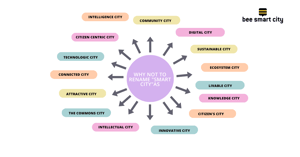In this article, I would like to explore the ongoing debate surrounding the term "smart city" and its relevance in addressing the challenges faced by cities today. With the world undergoing significant changes, including climate change, cyberattacks, growing urban density, and the COVID-19 pandemic, the term "smart city" coined by IBM and Cisco in the early 21st century may not fully address these emerging issues.
Cities are complex ecosystems shaped by diverse interests and ambitions. They face various challenges, such as providing citizens and visitors with a high quality of life, employment, education, technology, security, governance, mobility, open spaces, gender, planning, energy, and ICT (Information and Communication Technology). Yet, they also represent a vision of freedom, creativity, opportunity, sustainability, and prosperity. With over half of the global population living in urban areas, this percentage is projected to grow to 70% by 2050, making it imperative to address these challenges and capitalize on cities' potential.
Despite the lack of a universally accepted definition of a smart city, experts still use the term coined by IBM and Cisco in 2007. Various definitions exist, emphasizing the role of technology in making cities more efficient, cost-effective, and sustainable, while also improving the quality of life for citizens.
The article suggests a new definition of a smart city, emphasizing the importance of multi-sectoral stakeholder engagement, interdisciplinary partnerships, and a vision of inclusion and imagination to make a real difference in a changing world. Such a city encourages entrepreneurship, provides opportunities for new challenges, and serves its residents in multiple aspects, including culture, education, community, health, transportation, leisure, employment, housing, economy, and welfare, effectively enhancing human well-being.
Definitions of the Smart City: A Selection
Smart cities have been a buzzword for over a decade, but what exactly does it mean? Worldwide experts think there is no one acceptable definition of the term "smart city". However, they kept the term coined by IBM and Cisco in 2007. Some selected smart city definitions will be presented here as follows:
- Smart city uses ICT to be more efficient in the use of resources, resulting in cost and energy savings, improved service delivery and quality of life and reduced environmental footprint. All support innovation and the low carbon economy. Boyd Cohen- Smart City Wheel.
- A smarter city systematically creates and encourages innovations in the city systems that are enabled by technology that change relationships between the creation of economic and social value and the consumption of resources that contribute in a coordinated way to achieving a vision and clear objectives that are supported by a consensus amongst city stakeholders. Rick Robinson – IBM.
- A smart city is a city well-performing in a forward-looking manner, built on a 'smarter' combination of endowment and activities of self-decisive independent and aware citizens. These are based on the six "smarts": economy, people, governance, mobility environment, and living. Vienna, Center for Regional Science.
- A smart city uses technology and data to enhance its livability, workability, and sustainability. Adam Beck – Executive Director, Smart Cities Council Australia & New Zealand.
- A city that utilizes new technologies and innovations to promote productivity and efficiency, reduces waste and costs and enhances diversity and inclusion. Fiona Cho – Executive Director, Portfolio Management, Prudential Global Investment Management.
- Smart cities put data and digital technology to work to make better decisions and improve the quality of urban life. Jonathan Woetzel – McKinsey & Company.
The above definitions show a deep thinking development that has been created over the years on one hand and along the language development that was implemented by different uses. Thus, we can take, for example, the following "new" words that were adopted and used daily: ICT, city stakeholders, data, digital, sustainability, inclusion, and quality of urban life. Each of these words has meaning and expressions used by the wide population engaged in the topic of smart cities.
New Definition of "Smart City"
Being the co-partner of the Israeli Smart Cities Institute, I have been trying to improve and create a more understandable and new meaning to the term "smart city." Therefore, I propose a new definition for that term:
A smart city is a city that experiences and practices means to join and participate with multi-sector stakeholders and build interdisciplinary partnerships without both ego and politics. It maximizes bringing together the elements of a vision of inclusion and an imagination to become a real place for a take-off point in a changing world.
Thus, a smart city enables and encourages entrepreneurial initiatives, creates and produces opportunities for new challenges, and serves the city residents in multi-aspects improving the quality of life and equality through culture, education, community, health, transportation, leisure, employment, housing, economy, welfare being efficiency, and effective for the long range of human well-being. Therefore, a city will be defined as smart, attractive, happy, and caring for its different communities. Thus, a smart city is based on human, social, economic, and environmental capital.
My final thought suggests that we only name a city as "smart" according and specifically to its features, characteristics, qualities and vision as shown in the following table:

Each of the above names has many meanings and concepts and even theoretical possibilities of understanding. It requires long discussions and explanations as well as an agreement of mayors and stakeholders to dig deep into the concept of what it means to be a smart city in the 21st century while the world's ecosystems around us are changing, affected and impacted by virtual reality, artificial intelligent, robots, autonomous mobility, drones, cyber and human behaviour relationships to the innovative surroundings.
This article was written by Dr. Zvi Weinstein. Zvi is a multidisciplinary academic. He holds eight academic degrees among them: Urban Regeneration (PhD.), Town and Regional Planning (MSc.), Environment and Urban Sustainability (MA), Public Policy (MA), Law (MA). He was a former National Coordinator for Project Renewal of Disadvantaged Neighborhoods at the Ministry of Construction & Housing in the State of Israel during the years 1977-2015. Zvi is a Co-Founder of the Israeli Smart Cities Institute; long period member of the EU-COST Actions; Tutoring on a voluntary basis students writing their thesis about urbanism and social aspects topics; and participates in international conferences related to his field of interests; Furthermore, he has published more than 50 articles, researches and books.

